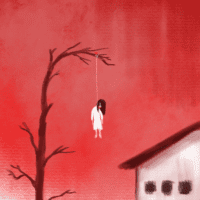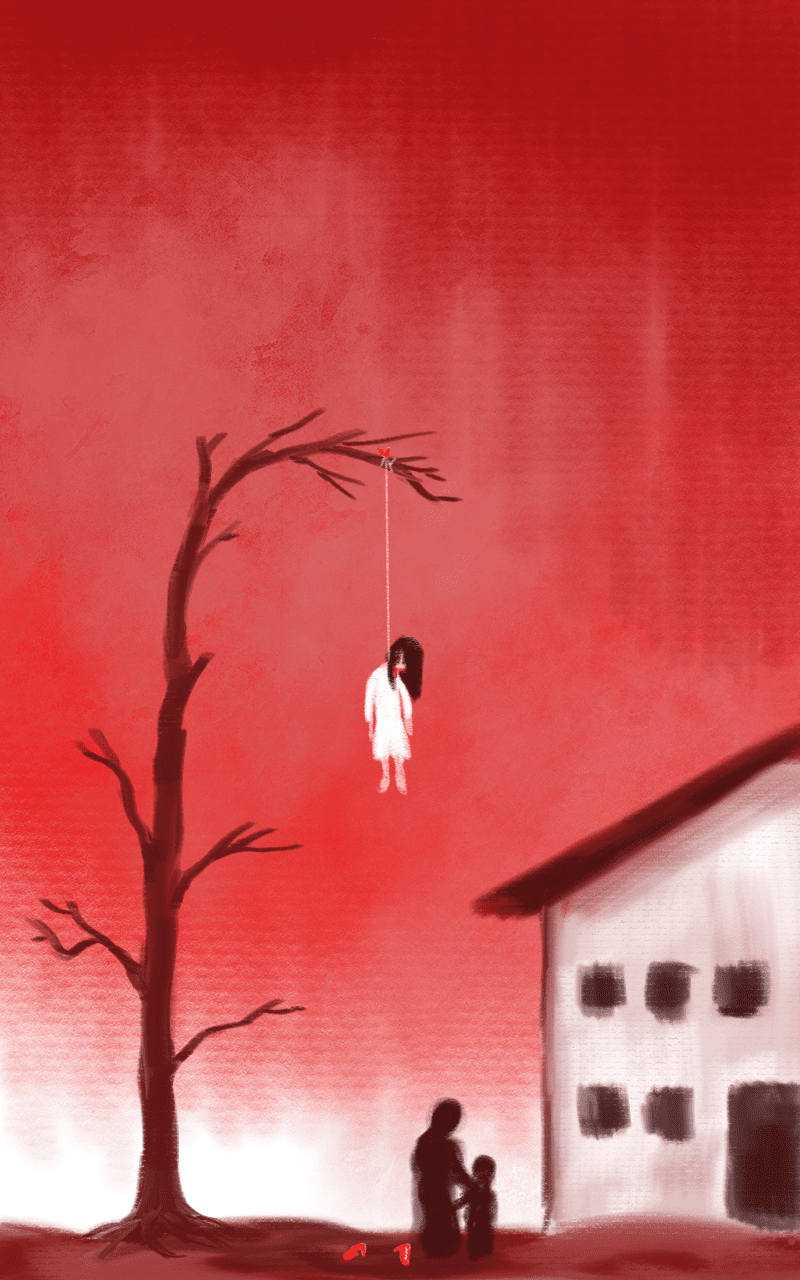At the end of the summer of 1974, President Nixon announced his resignation. The date was August 8, nearly a month after a woman named Teresita Angeles committed suicide. I might refrain from describing the method, but it is a salient detail for the effect it had on her daughter: hung using her jump rope, which Teresita had asked to borrow earlier that day. Teresita was thirty-one. What becomes clear in the midst of the act of reaching backward in time, perhaps even clearer when it involves someone you’ve never met, is that contact is impossible. There is a constant distance from truth and ownership. I never knew my grandmother, only felt her through the few times my mother has spoken about her. My grandfather, who grieved for his wife away from his children and remarried a few years later, never spoke of her at all. So my childhood was spent in ignorance of a person irrevocably important to my family, and to me.
Here, the reels switch. Feet dangle in the foreground, suspended in space by distance and gravity. This is the story of a haunting, so promises the screen, slow glances over lifted shoulders, down dark corridors while everyone else is asleep. This would be the story of a man tormented by a past that he had no involvement in. The ghosts would be vengeful and the blood would run freely. I can confidently tell you that the screen is lying, that this is not that story at all. This is about the bonds between an older generation of women whose decisions irrevocably affect the next generation’s livelihood. It is about the emotional absence of men who are also physically omnipresent. It is about what we tell ourselves went wrong when the victims aren’t around to tell the story. This is not a witch story, merely one that acknowledges their existence.
My mother struggled with depression throughout her adolescence as a result of the loss of her mother. Much of the family knew Teresita had been “sick.” There is commonly the claim of sickness and disbelief in any witch story. Rosemary Woodhouse knows this, experiences it in the print and film versions of Rosemary’s Baby, when unseen machinations for the possession of her body are set forth in ways she can’t tangibly describe but can palpably sense. Dancers Patricia and Sara know this, relive it in the original and newest versions of Suspiria, when they suspect danger, and the preying upon of young women might be the true foundation of a dance school they have called their home away from home from the very beginning. Thomasin in The Witch. Annie Graham in Hereditary. What becomes clear, especially in the case of women who are struggling to explicate their emotional and mental states while being deemed insufficiently lucid enough to make their own decisions or be granted the help they ask for, is that the absence of belief creates a vacuum into which doubt and guilt and shame might rush in. How do you know the things you say are chasing you are real? Point to it. Seize it, bring it into the light.
In cases like these, the person who might enact change through their belief, because of their proximity to power or their ostensible role as a protector, is a man. Annie, Patricia, Sara, Thomasin, and Rosemary all demand to be believed by the men in their lives, whether that be a father or a husband or a therapist, and they make it clear that the absence of that belief might destroy them. What is also true, in these films and in my mother and grandmother’s lives, is that the peril faced comes from an older generation of women, that it is aided by the dismissal of a man, but is not contingent upon it.
At the beginning of Rosemary’s Baby—released the year my mother was born—after Rosemary and her husband move into their new Manhattan home, after they are warned that the building is haunted by a violent past, the couple meets a young woman named Terry. Terry is the recipient of charity, an addict taken in by the elderly Castevet couple who live across the hall. Minnie and Roman Castevet have given their ward an odorous necklace, which Rosemary immediately notices. It is this necklace, and the subsequent transfer of satanic energy, that is then given to Rosemary by Minnie when Terry dies in the street after “falling” from the Castevet’s window. After Terry’s failure, Rosemary is to become an unwitting vessel for the son of the devil brought forth by the Castevet’s satanic cult. The women of the cult are barren. Rosemary has vitality.
Devil-worshipping is an enterprise common in witch stories, as is the preciousness of youth. Even if he is not the focus of a coven’s power, he is still the source, and his conduit is usually a young woman. In Hereditary, Annie Graham realizes her deceased mother was the leader of a similarly evil cult that seeks to bring “one of the Kings of Hell” to the mortal world so that he might bestow riches and power to them. The first sacrifice in this endeavor is Annie’s daughter Charlie. The effects of Charlie’s death, just weeks after Annie has buried her own mother, are incalculable. A rupture forms between Annie and her son Peter, whose inattentiveness to his sister’s health at a party leads to Charlie’s death. The vacuum opens and into it comes the influence of evil cloaked in altruism. By her mother’s design, Annie turns to forces she doesn’t fully understand. In the end, the entire family will succumb.
Evil has a grave influence on susceptible souls. It leads them to defile bodies through ritual and murder. This is part of the simple binary between good and evil and it provides culpability in situations where the truth is far less sensational. In the wake of my grandmother’s death, when her body was sent back home to the Philippines for burial, her family was suspicious of the circumstances surrounding her death. They believed my grandfather had been involved in some way. There was absolutely no chance she could have taken her own life. At the same time, my mother was told by her aunts and cousins that what was true of Teresita was evident in the absence she created. Suicide commits your soul to hell. There is no reckoning with it, the only thing you can do is move on. My grandmother’s youth was corrupted. My mother’s didn’t have to be—though, of course, that is not how that works.
There is an intense scrutiny of corruption in the lives of women who struggle with mental illness. Film and literature leave room for the ambiguous in stories of witchcraft. Fear, paranoia, self-hatred, anxiety, and the fight for physical or social autonomy may all be considered conduits for a commentary of mental health that is rarely explicit in media that also deals with the supernatural. If this type of representation and allegory of real life is true, it is a relatively new, flawed occurrence. Films like The Babadook and It Follows are stories of corruption where the female lead becomes dangerous purely by her proximity to the unknown. The former is the story of a mother and son haunted by an evil entity, which has been interpreted as an allegory for the grieving process or mental illness. The latter is about an unseen entity that stalks those who have contracted a sexually transmitted infection, which many have taken to be an allegory for HIV/AIDS. In both films, the dramatic tension comes from obstacles and aggressions that may not necessarily be specific to women, but are made more dangerous by their treatment in a world that was already aggressive toward or downright dismissive of women before the supernatural arrived. In most cases, once the victim has been selected, there is no turning back. Their corruption is an external reflection of something disturbed within, ushered by the guiding hand of the unseen.
This is not the part where I tell you mental illness is a corruption of personhood or of self. This is not the part where I say the weak are those who take their own lives, try to do so, think or have thought about doing so, or who experience the world outside the purview of what is considered normal. Our collective imagination conjures up ideas of what it means to persevere, what it means to endure pain and succeed through it, and how it is up to everyone individually to make sure that victory happens. This is magical thinking. The thornier truth is that we can’t choose the things that affect us, the words that pierce us most deeply, or the silences that confirm our most dreadful fears. What does it mean when people endeavor to encourage your “healing” or empowerment through isolation?
It takes repetition to give a spell its power. You can’t do anything. You are wrong. Forget, forget, forget.
No matter how affecting or resonant they may be, I believe it is important to be aware of who is most prominently featured in witch stories. After all, popular culture reserves the bonds and powers of sisterhood through witchcraft as a force created for and by white women. Any incidental women of color tend to be orientalist affectations of primitive animism or Judeo-Christian superstition. We see this clearly in Paranormal Activity 2, when a haunted family’s Latina housekeeper is insistent about the presence of evil spirits, when she burns sage in order to cast those spirits away, when she is fired for her hysterical behavior. Later in the series, we learn that the terror visited upon this family is the result of a powerful coven who will stop at nothing to ensure the arrival of an evil entity.
Many critics have argued that the modern depiction of witches as evil or morally ambiguous belies a deep-seated aversion to female power. This might be the case. The labelling of Hillary Clinton as the “Wicked Witch of the Left” by her opponents during the 2016 election comes to mind, as does the paradoxical invocation of the phrase “witch hunts” by men like Donald Trump and Israeli Prime Minister Benjamin Netanyahu who both seem to believe lack of support for—or public questioning of—their power pushes them down to the status of a woman who is being unfairly persecuted. But it is also true that solidarity amongst women, which has been increasingly spoken of as witchcraft, is not a given. We are almost always arguing over the passage of power from one group of white women to another. Liberation from colonial-era Puritanical repression and misogyny comes to Thomasin, not to the indigenous people living under colonialism. The women who dance around the fire and float into the night sky free from the oppression of a patriarchal world are as much sisters in appearance as they are in shared plight. As are those who survive the Black Sabbath ritual in Suspiria. As are those who are granted power in Hereditary. As are those who stated as fact Dr. Christine Blasey Ford’s strength in composure and emotional resonance compared to Anita Hill’s supposedly cold and disruptive demeanor. As are those who have told my mother that there can be no true solidarity in specificity of experience.
In Helen Oyeyemi’s novel White Is for Witching, what comes back to haunt Miranda, the protagonist, is both a family history of mental illness and its exacerbation by grief. There are no witches in this story, only legacies and ghosts. “Please tell a story about a girl who gets away,” she says. She continues:
From her fairy godmother. From the happy ending that isn’t really happy at all. Please have her get out and run off the page altogether, to somewhere secret where words like “happy” and “good” will never find her.
Miranda, my grandmother, my mother are asked by the mothering spirit of the past why happiness is not something they want. “I’m not sure what’s really meant by happy and good. I would like her to be free. Now. Please begin.”
***
Rumpus original art by Lisa Lee Herrick








